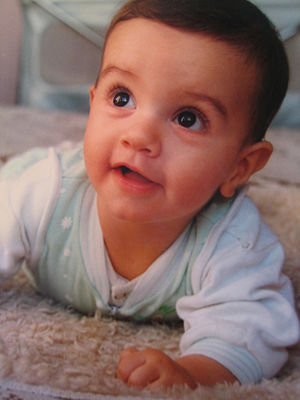That headline may seem silly to you, but it’s true. The classic Goodnight Moon by Margaret Wise Brown is for kids who are a little older, and who are ready to or are already talking. There are just too many words for babies. And you know what happens when babies are “over-stimulated”? They get fussy.

- Image via Wikipedia
I remember our baby doctor telling me once, “They start thinking the minute they come out of the womb.” He was laughing about something I said in regard to my daughter’s behavior when she was tiny. Nice man, Dr. Moriarty, yes… like the Sherlock Holmes villain, but he is anything but.
A big, jolly guy with a good heart. In fact, he created that green “Mr. Yuk” sticker that you have seen around for years to keep kids from getting into poisonous substances found around the house. I really appreciated him in Shannon’s early years.
But he had a point. Babies start thinking immediately, so don’t underrate them. They see things going on around them. They have no idea what the words are to associate what they’re seeing with the actual labels, but they’re learning.
And because they’re so young, they need to be taught in a very simple way.
What does a smile mean?
What’s that wonderful smell?
This thing wrapped around me feels nice when I touch it.
And why does that color make me happy?
Why does that noise make me feel sleepy?
How would you answer those questions? That’s a baby book. Here’s how you might write it:
My Room
Mommy is happy. (A picture of a woman smiling.)
I like my bottle. (A picture of a baby drinking a bottle.)
My blanket is soft. (A picture of a baby wrapped in a blanket.)
I like yellow flowers. (A picture of daffodils)
I hear sweet music. (A baby falling asleep and some musical notes around its head.)
You see? Simple sentences with visual associations. Create a story with see, hear, feel, taste, and touch. Of course, this one is rather lame, but well… you see what I’m getting at, yes? Teach babies to relate to their world, and you’ve got it in the bag.

